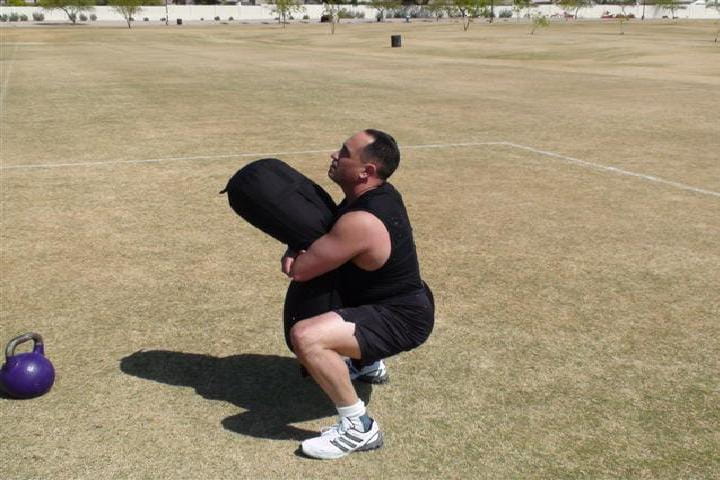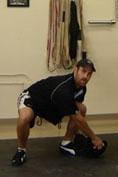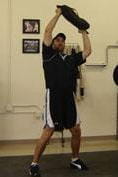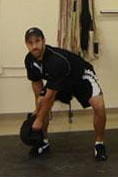Why go against the grain? Why be different than everyone else? These are questions I often ask myself when I write my programs. After all, wouldn't it be easier to conform to the popular fitness ideas like jogging on a treadmill or gliding on an elliptical machine? Well, "easy" doesn't get results!
The truth of the matter is after fifteen years of being called "crazy", "unorthodox", "weird", the very training methods that have produced my own clients' unparallel fitness results is becoming mainstream!
What type of training could be stir such controversy and yet yield benefits that are often missed with most common forms of training?
It would be the concept of odd-object training! Odd objects refer to training implements such as kegs, sandbags, kettlebells, heavy medicine balls, tires, stones, logs, and many more nonconforming objects. Like most newly exposed methods, odd object lifting was thought to be a fad and gimmick. However, unlike most new methods of fitness training, odd object lifting has a history of results that goes back thousands of years!


Don't Believe Me? These Guys All Train with Odd Objects
Most people get so focused on the interesting objects that are lifted, most miss the fact this style of training has immense physical benefits that can not be achieved with more common forms of training.
Functional Core Training: Many people fail in performing these lifts because their core is very weak. Odd objects place the body in new unfamiliar positions that have never been trained. Odd objects also can be place on the body in unique positions creating a completely new training stimulus for the core.
Extreme Calorie Burn: While the idea of training the whole body as one isn't a new concept, odd objects bring the point home in an extreme way. Your body has to use muscles that it never new it had and that means more calories burned. In addition, because you can not get into a simple groove with an odd object the body has to work harder on every single repetition to get the lift.
As famous strength author, Brooks Kubik, once stated, "You feel sore as you do because the bags (sandbags) worked your body in ways you could not approach with a barbell alone. You got into the muscle areas you normally don't work. You worked the "heck" out of the stabilizers."
Injury Prevention: Many people get hurt doing simple things because they simply haven't trained in real world functional ways. Using odd objects teaches the body to move more efficiently being an important method in preventing injuries such as the low back.
Allan Hedrick, Strength Coach for the Air Force Academy, wrote: "But, applying the concept of specificity, it makes sense that training with a fluid resistance is a more sport-specific method of training as compared to lifting exclusively with a static resistance, because in most situations, athletes encounter a dynamic resistance (in the form of an opponent) as compared to the static resistance. Further, because the active fluid resistance enhances the need for stability and control, this type of training may reduce the opportunity for injury because of improved joint stability." (NSCA Journal, Vol.25 Number 4)
For the majority of people, having stones, tires, logs, and other odd objects isn't realistic to their training. However, in the past few years, the most versatile odd object I have found possible to have in even a commercial gym is a sandbag.
Sandbags are unique in the fact they are the only implement that not only has a shifting weight, but alters its form as you lift it as well. It brings all the components of odd object lifting into one implement. Sandbags have long been used by elite wrestlers and martial artists for these very reasons.
Every exercise you know becomes exponentially more challenging with sandbags so old lifts become new, and there are plenty of new ones you can create with sandbag training. Here are a few examples of sandbags making certain exercises more challenging:
Sandbag Get-up
Lie completely on your back with the bag on one shoulder. Roll to the opposite shoulder and drive the opposite arm into the ground.
Slowly drive yourself up to a lunge position aiming to keep the chest very tall. Push through the ground to get to a standing position.
Very slowly return to the original on the ground position without looking downwards.
Muscles Trained: Abdominals, Hips
Sandbag Bear Hug Squat

With the chest elevated, push the knees outwards into a deep squat position.
Prevent any forward lean of the torso during any aspect of the lift.
Muscles Trained: Hips, Thighs, Abs, Arms, Upper Back
Sandbag Rotational Lunge
Begin standing with the sandbag in front of the body.
Lunge backwards while simultaneously twisting towards the opposite direction.
Press through the front heel to come back to the original position. Increase speed or swing of the sandbag to make the exercise more difficult.
Muscles Trained: Hips, Thighs, Obliques
Sandbag Shoulder Lunge
Begin with the bag on the outside of your legs. Squat down to grab the bag by the ends. Explosively rip the bag up above your head while transferring your weight to the opposite side. Repeat back to the original start position.


Muscles Trained: Glutes, Obliques, Shoulders
Sandbag Bent Over Row
Grab the bag and come to a full standing position. Bend at the hips and stick the butt back with a slight bend in the knees. Keeping a strong arch to the low back and the chest sticking outwards, pull the sandbag towards the lower part of the chest.
Make sure to squeeze the shoulder blades back and drive the elbows upwards.
Muscles Trained: Low Back, Upper Back, Biceps, Shoulders
Give odd-object lifts and sandbag training a try for yourself and I'm certain it'll spark new results if your routines have been boring lately! You can check out the Sandbags and the workout programs that come with the sandbag training system below…




No comments:
Post a Comment
What do you think about this quote? What's your favorite The Hangover. quote?